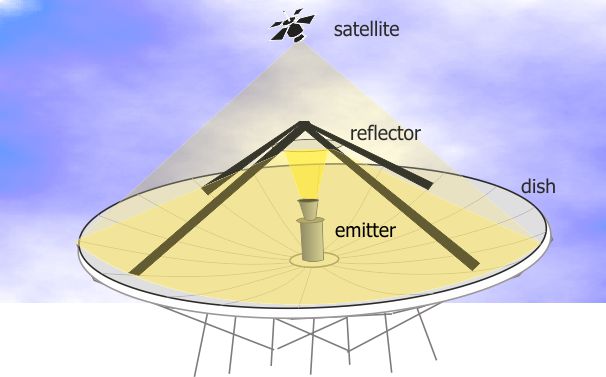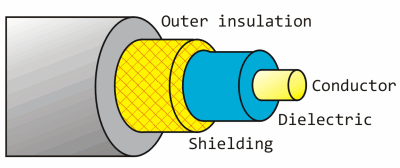Freesat reception - all about dishes
 Brian Butterworth published on UK Free TV
Brian Butterworth published on UK Free TV Satellite reception has both advantages and disadvantages compare with terrestrial (aerial) reception.
By using much higher frequencies (gigahertz, compared to terrestrial televisions megahertz) more transmission channels called transponders (the satellite equivalent of multiplexes) can be provided. For example, there are only six Freeview multiplexes, but Sky or Freesat users can access two hundred satellite transponders.
Aside from exceptional weather conditions (very heavy rain for example) digital satellite provides stable pictures and audio. Where Freeview transmitters are no more than 732 metres above sea level, the geostationary satellites used for television are 35,800,000 metres above the equator so reception is possible even where buildings, trees and hills make terrestrial reception impossible.

The downside of the transmitters being 22,300 miles up in the air is that the signals are very, very weak - so standard TV aerial is of little use. When the signals are sent to the satellites, huge dish transmitters are used to uplink the signal to the satellite. These are tens of metres from side to side, and feature an emitter that generates the signal, which is first bounced of a mirror (called a reflector) and then off the surface of the parabolic dish.

There are many satellites in the sky over the equator. Often these are in clusters over a particular position, for example there are four used for UK television are at 28.2 degrees east. There is another cluster over the 19.2 degrees east positions that are used for German television.
To receive these very weak signals from the satellite, it is necessary to use a dish for reception too. By using a reflective dish, this concentrates the signals onto a small device called a LNB. This is held in front of the dish by a metal arm.

The size of dish for reception is typically much smaller; often 60cm to 100cm in diameter, but the exact size depends upon the transmitting satellite transponder. To keep the transmission power levels down to levels that can be powered by the satellite's solar panels, each beam is focused on a particular area of the Earth's surface. If you are trying to receive the signal at the centre of this zone, a small dish is required. At the outer edges, you may need a 5 metre dish. Maps of these zones are provided by the satellite companies, and are called satellite footprints.
When the dish is installed it must be aligned carefully as the signal is very weak. The installer needs to know the inclination and the azimuth from the ground location to the satellite. If you install yourself you will find that there are markings on the dish that are used to point the dish in the correct position. It is important that the view of the satellite will not be blocked, so must take into account leaves growing on trees and potential building works.
For many people the LNB will have a single cable connected to it, however if you have Sky+ or a multi-room installation the LNB package will actually contain four receivers a quad-LNB. Unlike terrestrial television where you can split the aerial cable to feed more than one Freeview box or television set, with satelite reception you cannot. So, a Sky+ box with two receivers (so you can watch one thing and record another) has two cables connecting the box to the dish.
The cable that connects the dish to the receiver must be satellite grade cable. Whilst this looks superficially like the cable used to connect and aerial to a television, a higher grade cable is required for satellite reception.
Here is an image of a co-axial cable. This sort of cable is used to connect any type of receiving aerial to the reception equipment.

RG6, PF100 and PH100 are all types of coax cable that are suitable for the very weak signals that are received by a satellite dish. (The power is the same as you would receive from a one-bar electric heater on the moon).
The conductor in the centre passes the signals received from the dish to the set-top box. This is made from steel in RG6 cable, and from copper in the RF100 and PH100 types. This makes RG6 less suitable in the UK where rain can damage the cable.
The shielding is responsible for keeping unwanted external interference from damaging the signal. In the cheaper cable this will be a foil wrap, in better specified cables this is a braid (or mesh) of copper wires. The sheild in the RF100 covers 58% of the cable.
The non-conducting layer between the shield and the conductor is called the dielectric. This can be either a solid (RG6), foam (RF100) or air-spaced (PH100) dielectric. This makes the cables progressively more flexible (ie bendy without damage).
1:06 PM
robert gross: If you have standard Sky boxes and wish to discontinue the subscription they will continue to receive all the free to air channels. It is only when using Sky+ equipment, when ending the subscription would disable the record/playback function that you would need to replace your equipment in order to maintain the use of all functions.
| link to this comment |
6:24 PM
Why do I loose some signals on some Free-sat channels but not all ? And other times have no problems.I have done a reinstall but still the same.System = Bush BFSAT01HD
| link to this comment |
6:31 PM
Colin: Somewhere on your Freesat box you should be able to see signal strength/quality, check to see what you are getting. If weak then your dish may have moved or not been installed and aligned correctly or your LNB ( the bit with wires comeing out) may need replacing. Is the connection to your Freesat Box good? I found one where the central wire was bent over and not going into the central hole.
| link to this comment |
1:43 PM
We live just outside Paris use a satellite dish to watch BBC and ITV channels. Just realised we now need to switch to Astra 1N satellite for BBC. How do we get ITV channels please ? Any help would be much appreciated.
| link to this comment |
6:17 PM
Heather Naslin: When the channels moved from the Astra 2D satellite to the Astra 1N satellite, they mostly stayed on the same frequencies. You shouldn't have needed to do anything.
ITV have been moving services around a bit, so if they've moved your preferred regional service somewhere else, you might need to retune. If you have a Sky box, it should have retuned automatically, but you might need to check that the viewing card is properly inserted. Freesat boxes are supposed to retune automatically as well, but some of them need to be powered off and on again before they retune. Others actually have to be told to retune.
If you have a generic free-to-air receiver, not Freesat-branded, you'll have to retune it yourself. See http://lyngsat.com/28east.html for the frequencies to use.
| link to this comment |
6:37 PM
Hi,
I've just moved and am about to self install a dish to go with the Samsung Freesat HD recorder we have. How would I achieve multi-room (1 extra room)?
Thanks
| link to this comment |
8:44 PM
Paul: If its the case that you want to install an additional Freesat box (HD or otherwise) so that the second location can view different programmes from whatever is being viewed on the Samsung, then you have to ensure that a quad LNB is fitted onto the dish to enable you to run another feed from the dish to the second room.
However, if its simply the case of requiring whatever is being viewed on the Samsung to also be viewed in the second location then you could purchase one of these video sender units obtainable in places such as Argos etc, the sender being connected into the Freesat boxes rear scart socket and the receiver into the 2nd TV's similar scart socket, the signals sent via a radio link.
The other method (and similar to a Sky link) is to purchase an RF modulator to send an analogue RF signal to the second rooms TV, although this requires you to run a coax cable between both locations, the RF modulator being connected into the Freesat box in exactly the same way as the video sender, although in this case its a coax cable that's used to connect the modulator into the 2nd TV's aerial socket, and with viewing being made on the 2nd TV's analogue mode if its a dual standard TV.
By the way Sky boxes have modulators built in and they likewise do not require an additional device, Freesat boxes do not have this facility.
| link to this comment |
7:51 AM
Thanks for clear advice.
Looking to view different programmes in the two locations, so additional Freesat box looks like simplest option.
The house has an aerial pole fitted to the chimney, and I may need to use the height this gives to clear some trees. Should this give generally good recepetion or would the dish be susceptible to even slight wind movement.
Thanks
| link to this comment |
5:57 PM
Paul: Unfortunately a dish is very susceptible to being moved by even the smallest amount and so that aspect will have to be considered, but as a rough guide as far as obstructions are concerned, if you stand with your back to the wall facing at about 150 degrees or so and look upwards at roughly 25 degrees from the horizontal you have to be able to have an unobstructed view of the sky.
By the way, it doesn't matter how low down your dish is and can even sit on the ground, so long as the aforementioned is achievable.
| link to this comment |
7:35 PM
Paul - If you site and install your dish securely, it really shouldn't move unless your situation is seeing you very exposed to extreme weather conditions.
As JB38 points out,if at all possible a ground or near to ground, installation often can be made to be less obtrusive and has the advantage of ease of maintannce.
| link to this comment |